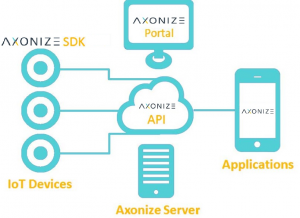Searching:
0 results foundHow Does Axonize Work?

The Axonize system comprises the following ‒
Axonize Portal
The Axonize Portal is a configurable easy-to-use user interface for monitoring and operating IoT Devices. See Axonize Portal ‒ User Guide for detailed usage instructions.
Note ‒ Currently, the Portal’s easy-to-use user interface provides most of the functionality that you need, as described in Creating an Application ‒ Workflow. However, a few steps for setting up the system must still be performed by a developer. The sequence of steps described in Creating an Application ‒ Workflow indicates when to use the Axonize Portal and when to use the Axonize REST API or Axonize Device SDK. Soon additional functionality will also be available in the Axonize Portal.
The Axonize Portal uses the Axonize REST API.
Axonize REST API
The Axonize REST endpoints enable you to activate Axonize functionality. The Axonize REST API enables you to ‒
- Activate Axonize Portal Functionality – The Axonize REST API enables you to perform all the functions provided in the Axonize Portal and more, such as creating a Product, a Device or a Rule and getting reports. See Axonize REST API Reference for a detailed description of these endpoints. For example, you can create Rules.
- Send Endpoints to a Device from the Axonize Portal ‒ The Axonize Portal sits on top of the Axonize REST API in order to send endpoints to a Device in order to affect how the Axonize Device SDK operates and to get Device events. In addition, you can use the API to send endpoints as needed. See Axonize REST API Reference for a detailed description of these endpoints. For example, you can create Devices.
- Activate Operations on a Device – The Axonize REST API enables you to send endpoints to a Real Device in order to activate operations on that Device, such as opening a light or closing a lock. See the sendCommand endpoint for a detailed description.
See Axonize REST API Reference for more details.
Axonize Device SDK
The Axonize Device SDK is installed on each Real Device so that the Device can send events to the Axonize Portal and can listen for endpoints from the Axonize Portal and Axonize REST API.
Axonize supports the following runtime environments on the Device ‒ Node.js, C, C#, Python and Java.
The Axonize Device SDK uses the AMQP (protocol) for connecting to the cloud. HTTPS and MQTT can also be used.
The Axonize Device SDK is a wrapper on top of the Azure IoT Hub SDK and can be used to send events to Axonize as long as the payload it is properly formatted.
Please contact Axonize support in order to get the Axonize SDK.
See Axonize Message Keywords.
Axonize Server
The Axonize Server enables you to monitor and control your Devices from a single consolidated repository. The Axonize Server collects all the Device events in one place so that you gain business insights from the events, in order to create new revenue streams and reduce operational costs.
The Axonize Device SDK can be installed on devices in order to send events to the Axonize Server. Alternatively, devices on which the Axonize Device SDK cannot be installed can send the events to the Axonize Server in their own format. Axonize then converts it to the proprietary Axonize data format. This conversion process is set up by Axonize support.
The Axonize Server’s architecture consists of three main layers:
- Axonize IoT AnyApp Layer ‒ The Axonize pre-built layer is suited for all businesses and provides a rich variety of configuration and customization options. This layer enables you to get and monitor information from various IoT and non-IoT Applications and to control these Devices.
- Axonize IoT Application Development ‒ Axonize provides its own proprietary IoT Application development framework, which is built from the ground up using breakthrough architecture to enable easy access and operation.
- Axonize IoT Services ‒ This is the infrastructure that interacts with the hardware layer and collects events and handles storage, security and so on. This layer is based on leading IoT services and cloud providers, such as Microsoft IoT Services.